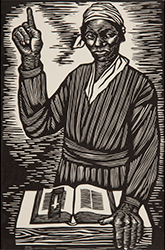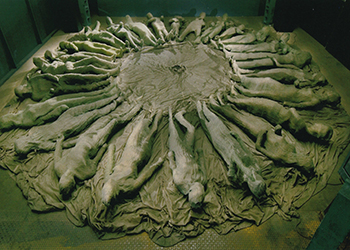Take a look at the picture to the left… The abstract. It’s large, five feet by four feet. It’s called Bride and Groom. The artist is Eve Garrison, a Chicago painter known in the 1920s and 1930s for her realistic portrait paintings and Chicago cityscapes. Then in the 1940s, she painted over assemblages of materials such as peach pits, pieces of rope, bottle tops and embedded glass, and called them “sculptural oils.”
By the 1950s, she noticed Jackson Pollock’s abstract expressionist paintings had become popular in New York City, and her work grew more abstract. She added cubist-like boxes of color and calligraphy to the figures she painted, which lent more content to the image and left viewers with more to observe and think about. Garrison’s paintings were shown in group exhibits in Chicago, as well as New York, Miami and Milwaukee. Her work was well known then, and she painted until 2001, when she was 98 years old.
If you keep looking at the painting pictured here, you can find the groom and his bride. See them? Look for their eyes…
Bride and Groom is one of 70 artworks you will see in the exhibition Making Their Mark: Illinois Women Artists, 1940-1960 at the Peoria Riverfront Museum (PRM), running October 17, 2015 through January 17, 2016. The women’s works are highly personal, subjective, and occasionally visionary or politically charged. They reflected their times—the Great Depression, World War II, the post-war prosperity of the conservative 1950s and the early revolutionary years of the 1960s.
The exhibition is a mix, certainly not a blending, of styles, subjects and mediums. The artists’ visions are exploratory, experimental, humorous, concerned. That’s what distinguishes Illinois art of this time period—especially Chicago art. What’s common about it—and therefore, the exhibition—are its differences. a&s
Channy Lyons is project director of the Illinois Women Artists Project, an online resource dedicated to recognizing the work of Illinois women artists. For more information, visit iwa.bradley.edu.
Reflecting the Times
 Tressa Emerson Benson painted narrative views of local subject matter in the manner of the American Scene painters of the late 1930s and 1940s. As art director at the Avery Coonley School in Downers Grove, Benson exhibited frequently at the Art Institute of Chicago and founded the Downers Grove Art Guild. It is believed the untitled painting shown here depicts a 4H display at a county fair.
Tressa Emerson Benson painted narrative views of local subject matter in the manner of the American Scene painters of the late 1930s and 1940s. As art director at the Avery Coonley School in Downers Grove, Benson exhibited frequently at the Art Institute of Chicago and founded the Downers Grove Art Guild. It is believed the untitled painting shown here depicts a 4H display at a county fair.

In the mid-1940s, Elizabeth Catlett produced a series of prints of impassioned images of revolutionary women from African-American history. Her print of abolitionist and women’s rights activist Sojourner Truth lecturing from the Bible emphasizes the importance of literacy and religion to the African-American community.
 Artist Gerda Meyer Bernstein was on one of the last Kindertransports that left Germany at the beginning of the war, taking refugee children to England. Fifteen years later, remembering back, Bernstein drew The Dictator, which she will lend for the PRM exhibit, noting that it began her “lifelong commitment to making work that addresses man’s inhumanity to man.” A more recent work, seen at left, is on display in the Hartmann Center Gallery at Bradley University through November 6th. The room-sized installation piece, entitled Marginalized, shows 22 shrouded female figures lying side by side in a circle, their feet pointing toward the center. The artist says it shows “my concerns with the inequality of women internationally.”
Artist Gerda Meyer Bernstein was on one of the last Kindertransports that left Germany at the beginning of the war, taking refugee children to England. Fifteen years later, remembering back, Bernstein drew The Dictator, which she will lend for the PRM exhibit, noting that it began her “lifelong commitment to making work that addresses man’s inhumanity to man.” A more recent work, seen at left, is on display in the Hartmann Center Gallery at Bradley University through November 6th. The room-sized installation piece, entitled Marginalized, shows 22 shrouded female figures lying side by side in a circle, their feet pointing toward the center. The artist says it shows “my concerns with the inequality of women internationally.”

Peoria Plays the PRM!
Also included in the Peoria Riverfront Museum exhibition are works by a number of Peoria artists, including sculptor Nita Sunderland, multimedia artist Maryruth Ginn, and three generations of Gibbs: painter Ramona Gibbs; her mother, sculptor Maurine Montgomery Gibbs; and her grandmother, painter Irene Wade Montgomery. Maurine Gibbs’ 1942 hand-carved mahogany sculpture, a New Deal commission entitled The Letter, still hangs in the lobby of the Homewood, Illinois post office. Shown here, Maurine Gibbs finalizes a plaster portrait of her daughter, Ramona, in her Rosemont, Pennsylvania studio in 1947.
A Tribute By Postcard
Barbara Aubin was a staunch supporter and promoter of women artists in Illinois. As one of the founders of the Chicago Women’s Caucus, she traveled the state teaching them “how to be professional”—how to write resumes, make slides and talk with gallery owners. She was fascinated by the contents of the undulating sea, which ended up in many of her paintings, such as the one shown here.
Aubin loved postcards: receiving them, creating them and sending them. In 1979, she invited artist friends from around the world to send her handmade postcards, which she mounted and exhibited in Chicago and throughout the state.
This fall, three Bradley University art students pay tribute to Aubin by curating an exhibition of postcards made by students currently enrolled in Illinois colleges and universities. These small masterpieces will be on display at the Prairie Center of the Arts through November 6, 2015.


